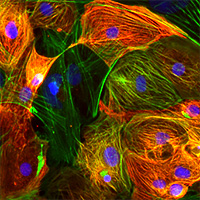20 years of human stem cell research
A look back at significant advancements from two decades of groundbreaking work
 Stem cells have risen to the forefront of biological discoveries and therapies, with expanding utility enabling scientists to dive into fundamental questions about cell differentiation and growth, organ development, and disease modeling. No small feat for so young a research area! Only 20 years have passed since the derivation of the first human embryonic stem cells (hESCs), yet researchers have pushed forward in impressive fashion, moving from that first discovery to drug development and clinical trials.
Stem cells have risen to the forefront of biological discoveries and therapies, with expanding utility enabling scientists to dive into fundamental questions about cell differentiation and growth, organ development, and disease modeling. No small feat for so young a research area! Only 20 years have passed since the derivation of the first human embryonic stem cells (hESCs), yet researchers have pushed forward in impressive fashion, moving from that first discovery to drug development and clinical trials.
1998
The late 1990s marked the first derivation of pluripotent embryonic stem cell lines from human blastocysts (Thomson et al. 1998), opening up significant new research possibilities. These five original hESC lines were able to maintain prolonged undifferentiated proliferation in vitro as well as the potential for germline development. Nonhuman ES lines had previously been available, but now researchers could start to investigate development and function in ways specific to humans and more relevant to clinical applications.
2000
Those first hESC lines were widely distributed, and two years of work brought forth another milestone: the advent of successful in vitro differentiation of those hESCs into the three embryonic germ layers (Itskovitz-Eldor et al. 2000). The authors were able to differentiate the ES cells into embryoid bodies that demonstrated the expected expression of markers specific to different cell types, including hematopoietic cells, myocardial cells, neuronal cells, and endodermal cells. When grown as monolayers, the cells even showed the ability to take on different morphologies and functions.
2002
The potential seen in earlier publications led to a concerted effort to investigate the multilineage potential of hESCs. Just two years later, the field advanced specific differentiation of hESCs into a wide range of mature cell types both in vivo and in vitro. Included among them were hematopoietic precursors and pancreatic islet-like cells, in addition to cardiac and neuronal cells (Ludwig and Thomson 2004).
2007
Continued focus on and research with hESCs gave scientists the clues needed to reprogram human somatic cells to behave in a pluripotent manner (Takahashi et al. 2007; Yu et al. 2007; Park et al. 2008). These human induced pluripotent stem cells (hiPSCs) resembled hESCs in essential characteristics, including morphology, gene expression, and proliferation. Because this new technology allowed researchers to start from adult, differentiated cells, the possibilities opened up for drug development and even disease modeling using patient-specific samples.
2008
Previous advancements in somatic cell reprogramming used fibroblasts to produce the hiPSCs, and scientists started to look for cell types that would be easier to obtain and usher in a higher-efficiency system for study. Just one year after the first production of hiPSCs, researchers reported derivation of hiPSCs from human keratinocytes (Aasen et al. 2008; Maherali et al. 2008). This proved to be 100-fold more efficient and twofold faster than earlier methods. Better yet, these hiPSCs could be generated from just a single human hair. In 2010, researchers published the reprogramming of peripheral blood cells, providing yet another avenue for easier access to starting material, including frozen patient samples stored in blood banks (Staerk et al. 2010; Loh et al. 2010).
Moving forward: 2018 and beyond
Progress in the field continues to be impressive, with an increasing number of publications covering everything from basic questions of tissue generation and human embryology to applications that directly affect human health, like disease modeling and regenerative medicine. What started out as five hESC lines 20 years ago has blossomed into hundreds of hESC lines and thousands of hiPSC lines available for use (Ludwig et al. 2018). Since 2008, increased investment has energized basic, translational, and clinical research, with the California Institute for Regenerative Medicine approving funding for their 50th clinical trial just this month. Notably, the first clinical trials using hESC-derived cells to treat spinal cord injury launched in 2010 and laid the groundwork for related trials that have shown promising results in terms of safety and efficacy, and that are advancing to the next phase. Each step forward brings with it new questions to investigate, and new potential for improving the human condition. If the past two decades are any measure, the future of stem cell research will continue to be an exciting, fast-paced environment with vast and varied possibilities.
References
Aasen, T. et al. Efficient and rapid generation of induced pluripotent stem cells from human keratinocytes. Nat. Biotech. 26, 1276–1284 (2008).
Itskovitz-Eldor, J. et al. Differentiation of human embryonic stem cells into embryoid bodies comprising the three embryonic germ layers. Mol. Med. 6, 88–95 (2000).
Loh, Y. H. et al. Reprogramming of T Cells from Human Peripheral Blood. Cell Stem Cell 7, 15–19 (2010).
Ludwig, T. and Thomson, J.A. Current progress in human embryonic stem cell research. In Monitoring Stem Cell Research, A Report of the President's Council on Bioethics (Diane Pub Co), 279–294 (2004).
Ludwig, T. E. et al. 20 Years of Human Pluripotent Stem Cell Research: It All Started with Five Lines. Cell Stem Cell 23, 644–648 (2018).
Maherali, N. et al. A high efficiency system for the generation and study of human induced pluripotent stem cells. Cell Stem Cell 3, 340–345 (2008).
Park, I. H. et al. Reprogramming of human somatic cells to pluripotency with defined factors. Nature 451, 141–146 (2008).
Staerk, J. et al. Reprogramming of peripheral blood cells to induced pluripotent stem cells. Cell Stem Cell 7, 20–24 (2010).
Takahashi, K. et al. Induction of pluripotent stem cells from adult human fibroblasts by defined factors. Cell 131, 861–872 (2007).
Thomson, J. A. et al. Embryonic Stem Cell Lines Derived from Human Blastocysts. Science 282, 1145–1147 (1998).
Yu, J. et al. Induced pluripotent stem cell lines derived from human somatic cells. Science 318, 1917–1920 (2007).
Stem cell overview
Overviews and discussions on a variety of stem cell research topics.
Stem cell reprogramming, culture, engineering, differentiation, and analysis
Takara Bio USA, Inc.
United States/Canada: +1.800.662.2566 • Asia Pacific: +1.650.919.7300 • Europe: +33.(0)1.3904.6880 • Japan: +81.(0)77.565.6999
FOR RESEARCH USE ONLY. NOT FOR USE IN DIAGNOSTIC PROCEDURES. © 2025 Takara Bio Inc. All Rights Reserved. All trademarks are the property of Takara Bio Inc. or its affiliate(s) in the U.S. and/or other countries or their respective owners. Certain trademarks may not be registered in all jurisdictions. Additional product, intellectual property, and restricted use information is available at takarabio.com.





